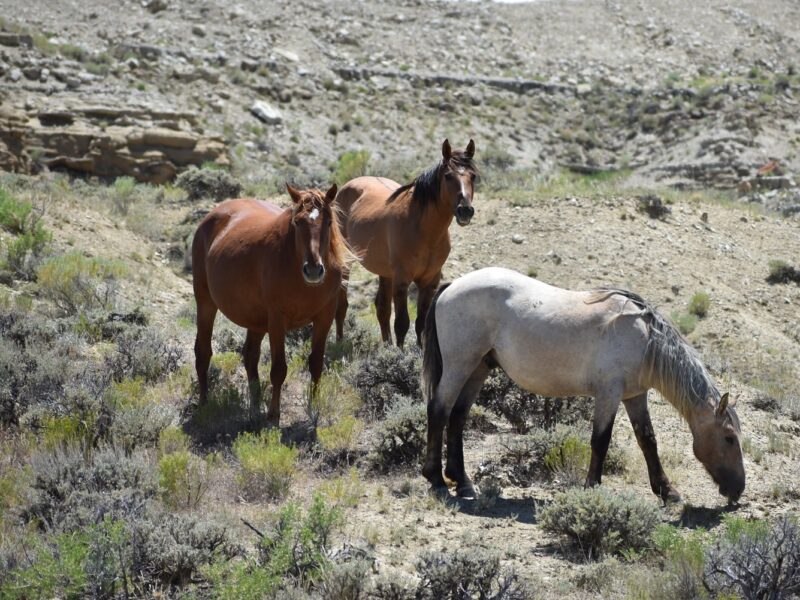Researchers Call for Changes to Federal Government’s Management of Wild Horses and Burros
Overpopulation could have negative ecological impacts, they claim
- Published In: Other News & Features
- Last Updated: May 13, 2023

Pictured above are wild horses from the Bureau of Land Management's Adobe Town Herd Management Area in southern Wyoming. Researchers are calling for changes to the federal government’s approach to managing wild horses and burros. (Courtesy photo from Jacob Hennig)
By Shen Wu Tan
Special to the Wyoming Truth
Researchers at the University of Wyoming (UW) and Oklahoma State University assert in a new study that the federal government will fail at managing wild horses and burros unless it changes its policies.

They argue that existing government programs are unable to manage these feral equids, or mammals of the horse family, since these animals are simultaneously handled as pets, livestock and wildlife, according to their recently published article in BioScience.
“Feral horses and burros living on designated Bureau of Land Management and US Forest Service lands are currently labeled as ‘wild,’” Jacob Hennig, a UW graduate, current postdoctoral researcher at Oklahoma State University and lead author of the study, told the Wyoming Truth.
“However, horses and burros are not ‘native’ wild species and current management practices are not typical of a wild species, rather they are an amalgamation of wildlife, livestock and pet population management,” he said. “If we truly want to treat horses and burros as wild species, that is completely fine, but we should then manage them as such.”
Two of Hennig’s former UW advisors, Jeff Beck and J. Derek Scasta, co-authored the article. The other researchers hail from Oklahoma State University, Colorado State University and Native Healing, LLC in New Mexico.
It is illegal under federal law to hunt wild equids, which have no natural predators. They also are no longer slaughtered as livestock in the United States. As a result, the number of equids on the range have more than doubled in the last decade, the researchers claim, while the number of equids held in government facilities and private lands have increased by 33% in the same time frame.
The Bureau of Land Management (BLM) has upped the number of equids removed from the wild in the past four years. Yet, the researchers claim that removing wild horses and burros from Western rangeland and relocating them into long-term holding is not the answer, but rather “exports the issue elsewhere” and could have unknown ecological impacts.
They also note wild horses and burros have a larger effect on the range because they consume more water and forage more than other animals, such as cattle. Overpopulation of any large herbivore could lead to changes in plant community composition, diversity and structure, while increasing bare ground and potential for soil erosion, Hennig added.
There are about 82,883 horses and burros on BLM lands nationwide as of March 1, but the “appropriate management level” is only 26,785, according to Hennig, citing government data – a difference of about 56,000. He noted that although the BLM removed 20,193 wild horses and burros from the range last year, their population actually grew by about 500 animals.
Approaches for managing wild horses, burros
While the BLM has increased fertility control research and practices, the study’s authors say the agency will be unable to manage these wild horses without removing tens of thousands of them through adoption, euthanasia or sale to slaughter.
“Like other ungulate populations, a hunting or culling program needs to be implemented to keep populations in check to prevent resource degradation,” Hennig said. “If we view these animals as livestock, then current gather and removal practices can continue. But the restrictions on sale or slaughter need to be lifted to give the animals monetary value.”
Under the federal Wild and Free-Roaming Horses and Burros Act of 1971, wild horses can freely roam like wild animals, yet hunting them is prohibited. As the law states, “Congress finds and declares that wild free-roaming horses and burros are living symbols of the historic and pioneer spirit of the West; that they contribute to the diversity of life forms within the nation and enrich the lives of the American people.
The BLM manages wild horses and burros on 26.9 million acres of public lands across 10 Western states. Wyoming has an estimated 8,828 wild horses, BLM statistics show, and most roam the southwestern region of the state.
James M. Fisher, lead public affairs specialist for the BLM office in Wyoming, said the agency is bound to enforce the Wild Free-Roaming Horses and Burros Act of 1971, which requires the protection, management and control of the animals on public land.
“Each Herd Management Area has a set Appropriate Management Level,” Fisher told the Wyoming Truth. “If horse counts go beyond the maximum figures, it’s our duty—per law—to conduct gathers.”
In an April statement, the BLM said this year’s estimated population of wild horses and burros remained “relatively static” compared to 2022, noting the population has dropped from a peak of over 95,000 animals in 2020. The agency also has increased the use of fertility control to slow the growth of herds, including the authorization of two studies of new fertility control vaccines at a corral facility in Carson City, Nevada.
The study authors say the BLM’s practice of removing wild horses is more similar to livestock operations than wildlife management while feral equids have turned into society’s pets through adoption programs, abolition of slaughter and sales restrictions.
During this year’s general legislative session, Wyoming lawmakers attempted to pass a joint resolution on wild horses and burros management practices. The bill, sponsored by Rep. John Winter (R-Thermopolis), asked the U.S. Congress to enact legislation and policy changes that would allow for equine slaughter and processing for shipment to markets inside and outside the country as a way to manage the animals.
“…The numbers must be reduced first,” Winter, a rancher and former BLM range conservationist and wild horse specialist in the Rock Springs district, told the Wyoming Truth. “The fertility control idea might have some merit once the herds have been reduced. Whether the horses have been treated with a fertility drug or not, they still eat, and horses do a good job of eating.”
“The major problem at this stage is the fact that the processing facilities in Canada have been closed,” he added. “Other than the facilities there, the only other place to take them is Mexico. It is my understanding that these horses must be placed in quarantine for weeks before they can enter the country…. The real answer is for the USA to have our own facilities where they can be regulated.”
The resolution died in the Senate agriculture committee after a 2-2 vote on the bill in February, but Winter said he will keep pressing the issue until it is resolved.













